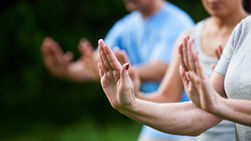Checkin in with your perception of playing your instrument
- Akiko Tsukamoto

- Sep 14, 2017
- 3 min read
QUESTION:
I am a guitarist and I have spasms whenever I hover my arm over my guitar. How do you think I should approach this?
ANSWER:
The spasms are a nightmare. This is where I started as well. I could not control the tension when I approached the keyboard.
You really want to be creative in all possible ways to not spasm when you approach your guitar. This is the first building block and I would spend A LOT of time just coming up with creative ways to not spasm before you even hold the guitar, before you can start initiating the movement to play the first note.
I also think this is the most crucial building block, as it is practically impossible to build any pathway on top of already shaky ground. Some people disagree with me. I am totally into it, and especially if we are looking for a non-reversing effect.
The way I look at FD and retraining is that it's a perception game. Our perception directly influences our thought patterns, motor and sensory signals.
Let's find a way to disrupt your thinking patterns when you want to play anything with the guitar by intentionally changing your perception around a little bit.
Some ideas to get you started...
Are there any moments in your day to day activity when you are completely free of spasm?
For example.... I was symptom free when
+ walking with a book under my arm + when I pretended that my hand wasn't mine when i put it right in front of me upright + i had my palm facing up when laying down + i was walking and thinking of something other than my hand
Whatever your 'free of dystonic symptom ' is in your daily activity (we all have more or less 16 waking hours a day, you probably don't have dystonic symptoms 16 hours a day) we want to start introducing guitar into that zone and give your body a conscious decision not to react to it.
Since I could somewhat control my tension when I was walking, I would walk around swinging my hand for a minute and see i can just 'accidentally' touch the piano while I was swinging my hand. After a while, my mind/body gains confidence on not reacting dystonically to touching the piano while moving my arms in a way I usually walk.
The point is... that you want to spend as much time on doing just that and call it a retraining, until you are so confident that you can accidentally touch the instrument and not react.
Now the beauty of a guitar is, unlike a piano which is stationary, it is movable to fit into your body instead of the other way around.
If you can find an activity that you don't have any reaction, you can ask somebody to just slide a guitar into your body without you moving your body out of position from whatever that activity is.
You might need a good assistant in doing that.
Don't worry you are absolutely not wasting any time trying to consciously practicing walking or any other activity that is not related to guitar playing at all if you can achieve the goal of not reacting when your arm is over the guitar. This is your retraining.
You can break the retraining in many segments a day and you can do this all day long if you don't exhaust yourself.
Some tips
You must absolutely be on the move whilst finding and being in that zone. Even if the move is so small that nobody but yourself can tell. Don't stop when you accidentally touch the instrument, but keep on moving.
Try moving from the core of the body instead of giving any initiative to your fingers or your hands. The fingertip movement should only be a the last end of the ripple effect on you moving the body.
Your intention of playing the guitar is 'contaminated' with dystonic symptom. Try to avoid that set of intension. Don't worry you are not going to forget how to play your guitar.
Once this building block is there, everything that you want to build there on after becomes easier and easier.
































Comments